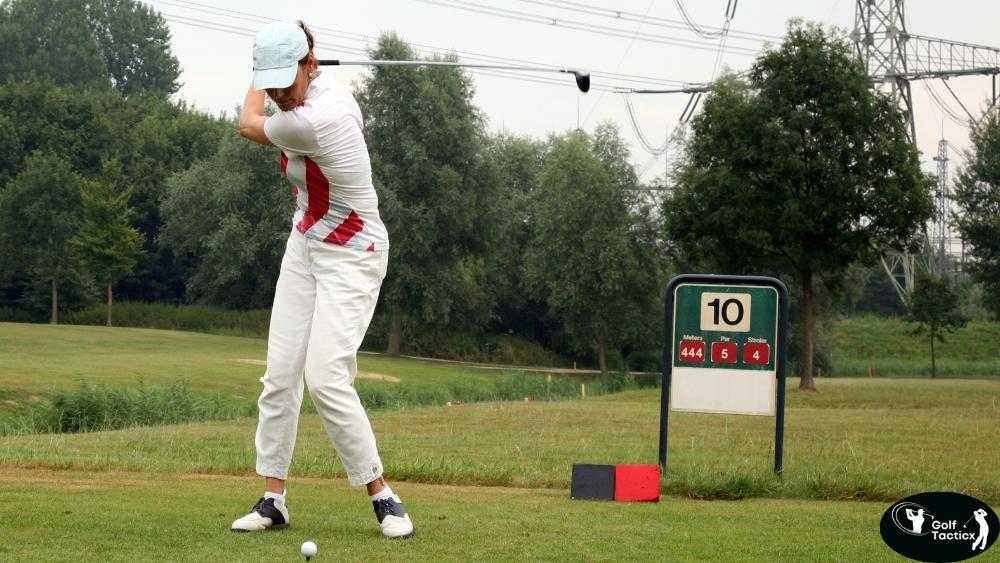In our previous lesson, we explored how to execute precise trajectory control in golf. Today, we’re diving into a specific shot that can add versatility to your game, the low-spin stinger shot. Mastering this shot will allow you to navigate windy conditions and tight fairways with confidence.
But beyond just looking impressive, hitting a low-spin stinger shot gives you more control over distance and roll, especially on firm ground. It’s a valuable option when you need to keep the ball under the wind or avoid trouble off the tee.
Whether you’re playing on a links course or facing unpredictable weather, adding this shot to your skillset can lower your scores and boost your confidence under pressure. In this guide, we’ll break down what makes the stinger unique and show you how to practice it effectively. With the right technique and mindset, hitting a low-spin stinger shot can become a reliable part of your arsenal.
What Is a Low-Spin Stinger Shot?
A low-spin stinger is a golf shot characterized by:
- Low Trajectory: The ball flies low to the ground, reducing the impact of wind.
- Minimal Spin: Less backspin means the ball rolls more upon landing, covering more distance.
This shot is particularly useful when you need to keep the ball under the wind or avoid obstacles like trees.
Why Should You Learn the Low-Spin Stinger?
Mastering the low-spin stinger offers several advantages:
Wind Resistance: The low flight path helps the ball cut through the wind, maintaining distance and accuracy.
Control: Less spin means the ball is less likely to veer off course, providing greater directional control.
Versatility: This shot can be used with various clubs, making it adaptable to different situations on the course.
Confidence Under Pressure: Hitting a low-spin stinger shot gives you a reliable option when precision is a must, such as on narrow fairways or when playing a critical hole. It’s a shot you can trust when others may feel too risky.
Better Course Management: Incorporating this shot into your strategy allows you to make smarter decisions off the tee or from the fairway, especially when avoiding hazards or shaping around trouble areas.
Low Maintenance on Landing: Because the ball stays low and rolls out, it reduces the chances of plugging or stopping abruptly—ideal for firm or fast conditions where carry isn’t everything.
Consistency Across Conditions: Whether it’s a breezy morning or a dry, fast afternoon round, hitting a low-spin stinger shot adds consistency to your game and reduces the unpredictability of high, spinning shots.
Key Elements of the Low-Spin Stinger
To execute a low-spin stinger, focus on the following:
Club Selection: Start with a 5-iron. This club offers a good balance between distance and control.
Ball Position: Place the ball slightly back in your stance to promote a descending strike.
Grip: Maintain a firm grip to prevent excessive wrist action, which can add unwanted spin.
Swing Path: Focus on a low, sweeping swing path to keep the ball flight low.
Follow-Through: Keep your follow-through compact and low to maintain control.
Step-by-Step Guide to Hitting the Low-Spin Stinger
Follow these steps to master the low-spin stinger:
Set Up Properly:
- Position the ball slightly back in your stance.
- Keep your weight slightly forward, favoring your front foot.
- Grip the club firmly to minimize wrist movement.
Execute the Swing:
- Take a controlled backswing, focusing on a low, sweeping path.
- At impact, ensure the clubface is square to the target line.
- Maintain a low follow-through, keeping your hands below shoulder height.
Practice Regularly:
- Incorporate this shot into your practice routine to build consistency.
- Start with shorter irons and gradually work up to longer clubs as you gain confidence.
Common Mistakes to Avoid
Be mindful of these common errors:
Overcomplicating the Swing: Keep your swing simple and controlled.
Incorrect Ball Position: Placing the ball too far forward can lead to higher ball flights.
Excessive Wrist Action: Avoid flipping your wrists at impact to maintain control.
Equipment Considerations
Selecting the right equipment can aid in executing the low-spin stinger:
Clubs: A 5-iron is a good starting point for this shot.
Golf Balls: Choose balls with lower spin rates to help achieve the desired flight.
When to Use the Low-Spin Stinger on the Course
Knowing when to rely on the stinger can give you a major edge during play. Hitting a low-spin stinger shot is most effective when conditions call for a controlled, penetrating ball flight. It’s a smart choice:
- In windy conditions: Helps reduce spin and prevents ballooning.
- On tight fairways: Prioritizes accuracy over height.
- On links-style or firm courses: Encourages extra roll after landing.
- When distance control matters: Keeps the ball under the wind with less curve.
- From the tee on short par 4s: A safer alternative to the driver.
By learning the right moments to use it, hitting a low-spin stinger shot becomes not just a flashy trick, but a valuable course-management tool.
Comparing High-Spin vs. Low-Spin Shots
| Feature | High-Spin Shot | Low-Spin Stinger Shot |
|---|---|---|
| Ball Flight | High, with more spin | Low, with reduced spin |
| Wind Resistance | More affected | Less affected |
| Roll After Landing | Minimal | Significant |
| Use Case | Soft approaches | Windy tee shots, tight fairways |
| Difficulty | Easier to stop | Requires precise control |
Mental Approach: Staying Committed to the Shot
Success with the stinger shot doesn’t just come from physical technique—it also depends on a strong mental game. When hitting a low-spin stinger shot, it’s essential to stay committed to your target and swing with full confidence.
Many players hesitate, fearing the ball won’t fly far enough or might dive too low. But with solid fundamentals, the stinger becomes a dependable choice. Visualize the flight, trust your mechanics, and swing through the ball. The more you practice under real-course pressure, the more natural hitting a low-spin stinger shot will feel.
Conclusion
Mastering the low-spin stinger shot can add a valuable tool to your golfing arsenal. By focusing on proper setup, swing mechanics, and equipment selection, you can execute this shot with confidence. Remember, consistent practice is key to mastering this technique. Keep practicing, and you’ll soon be hitting low-spin stingers like a pro!
In addition, learning when to use the stinger, such as during narrow tee shots, windy par threes, or firm fairways, can give you a strategic edge on the course. It’s not just about technique; it’s also about smart decision-making. As you gain experience, you’ll start to recognize ideal situations for pulling out this shot under pressure. And when done right, hitting a low-spin stinger shot can become your go-to move in clutch moments.
In our next post, we’ll dive into the art of Mastering Shot Shaping, transforming your ability to manipulate the ball flight and tackle any course challenge that comes your way.
















Leave a Reply